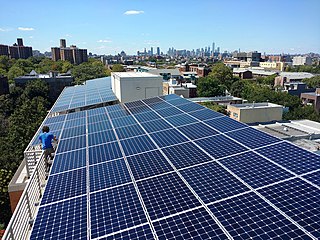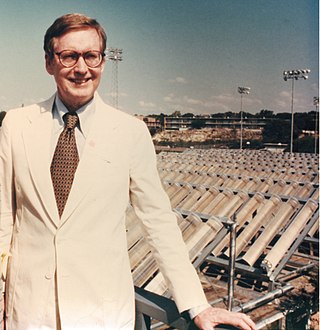
A solar inverter or photovoltaic (PV) inverter is a type of power inverter which converts the variable direct current (DC) output of a photovoltaic solar panel into a utility frequency alternating current (AC) that can be fed into a commercial electrical grid or used by a local, off-grid electrical network. It is a critical balance of system (BOS)–component in a photovoltaic system, allowing the use of ordinary AC-powered equipment. Solar power inverters have special functions adapted for use with photovoltaic arrays, including maximum power point tracking and anti-islanding protection.

Solar shingles, also called photovoltaic shingles, are solar panels designed to look like and function as conventional roofing materials, such as asphalt shingle or slate, while also producing electricity. Solar shingles are a type of solar energy solution known as building-integrated photovoltaics (BIPV).

Building-integrated photovoltaics (BIPV) are photovoltaic materials that are used to replace conventional building materials in parts of the building envelope such as the roof, skylights, or façades. They are increasingly being incorporated into the construction of new buildings as a principal or ancillary source of electrical power, although existing buildings may be retrofitted with similar technology. The advantage of integrated photovoltaics over more common non-integrated systems is that the initial cost can be offset by reducing the amount spent on building materials and labor that would normally be used to construct the part of the building that the BIPV modules replace. In addition, BIPV allows for more widespread solar adoption when the building's aesthetics matter and traditional rack-mounted solar panels would disrupt the intended look of the building.

Green Mountain Energy is a United States company that sells green electricity products via renewable energy credits.

Solar power includes solar farms as well as local distributed generation, mostly on rooftops and increasingly from community solar arrays. In 2023, utility-scale solar power generated 164.5 terawatt-hours (TWh), or 3.9% of electricity in the United States. Total solar generation that year, including estimated small-scale photovoltaic generation, was 238 TWh.
Sunrun Inc. is an American provider of photovoltaic systems and battery energy storage products, primarily for residential customers. The company was established in 2007 and is headquartered in San Francisco, California.

The use of solar energy began in Israel in the 1950s with the development by Levi Yissar of a solar water heater to address the energy shortages that plagued the new country. By 1967 around 5% of water of households were solar heated and 50,000 solar heaters had been sold. With the 1970s oil crisis, Harry Zvi Tabor developed the prototype of the solar water heater now used in over 90% of Israeli homes. There are over 1.3 million solar water heaters installed as a result of mandatory solar water heating regulations.

Solar power has been growing rapidly in the U.S. state of California because of high insolation, community support, declining solar costs, and a renewable portfolio standard which requires that 60% of California's electricity come from renewable resources by 2030, with 100% by 2045. Much of this is expected to come from solar power via photovoltaic facilities or concentrated solar power facilities.

Leonard "Lynn" L. Northrup Jr. was an American engineer who was a pioneer of the commercialization of solar thermal energy. Influenced by the work of John Yellott, Maria Telkes, and Harry Tabor, Northrup's company designed, patented, developed and manufactured some of the first commercial solar water heaters, solar concentrators, solar-powered air conditioning systems, solar power towers and photovoltaic thermal hybrid systems in the United States. The company he founded became part of ARCO Solar, which in turn became BP Solar, which became the largest solar energy company in the world. Northrup was a prolific inventor with 14 US patents.
PACE financing is a means used in the United States of America of financing energy efficiency upgrades, disaster resiliency improvements, water conservation measures, or renewable energy installations in existing or new construction of residential, commercial, and industrial property owners. Depending on state legislation, PACE financing can be used to finance water efficiency products, seismic retrofits, resiliency, and other measures with social benefits.

A community solar project, farm or garden is a solar power installation that accepts capital from and provides output credit and tax benefits to multiple customers, including individuals, businesses, nonprofits, and other investors. Participants typically invest in or subscribe to a certain kW capacity or kWh generation of remote electrical production. The project's power output is credited to investors or subscribers in proportion to their investment, with adjustments to reflect ongoing changes in capacity, technology, costs and electricity rates. Community solar provides direct access to the renewable energy to customers who cannot install it themselves. Companies, cooperatives, governments or non-profits operate the systems.

Sunetric is a Hawaii-based photovoltaic solar power company that performs consultation, design, and installation of photovoltaic systems for residential, commercial, military, and non-profit customers. Sunetric operates on all of the Hawaiian islands and in several states in the continental US. The company was founded in 2004 as Suntech Hawaii by Sean Mullen. Alex Tiller is the company's CEO. The company handles system consulting, design, and installation, and remains responsible for maintenance, monitoring, and repairs.

A rooftop solar power system, or rooftop PV system, is a photovoltaic (PV) system that has its electricity-generating solar panels mounted on the rooftop of a residential or commercial building or structure. The various components of such a system include photovoltaic modules, mounting systems, cables, solar inverters battery storage systems, charge controllers, monitoring systems, racking and mounting systems, energy management systems, net metering systems, disconnect switches, grounding equipment, protective devices, combiner boxes, weatherproof enclosures and other electrical accessories.
The following outline is provided as an overview of and topical guide to solar energy:
The United States state of Arkansas is a significant producer of natural gas and a minor producer of petroleum.

Heliopower, Inc. is a United States–based company founded in 2001. HelioPower develops proprietary projects with third-party off-takers and currently owns and operates more than 100 energy systems at facilities such as the Tech Museum of Innovation in San Jose and Ronald McDonald House in San Diego.
The Boulder Solar project is a 150 megawatt (MWAC) photovoltaic power station near Boulder City, Nevada. It was built in two phases by SunPower using its Oasis Power Plant system. The project is co-located with several other large solar power projects in the Eldorado Valley.
The SunShot Initiative is a federal government program run by the US Department of Energy's Solar Energy Technologies Office. It bills itself as a national effort to support solar energy adoption in order to make solar energy affordable for all Americans. The initiative is a collaboration of private companies, universities, state and local governments, and nonprofits, as well as national laboratories.
Net metering in New Mexico is a set of state public policies that govern the relationship between solar customers and electric utility companies.
The Beacon Solar Project is a photovoltaic power station in the northwestern Mojave Desert, near California City in eastern Kern County, California. Split into five phases, the combined Beacon solar facilities generate 250 MW of renewable energy for the Los Angeles Department of Water and Power (LADWP). The five phases of the project, fully completed in December 2017, include a total of 903,434 individual solar photovoltaic modules, mounted onto Nextracker single-axis tracking systems.













